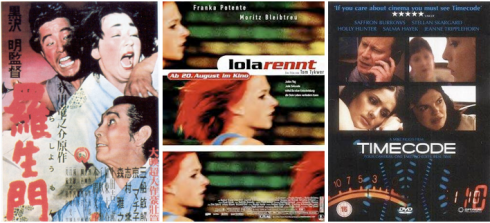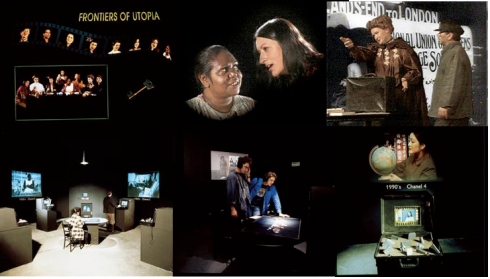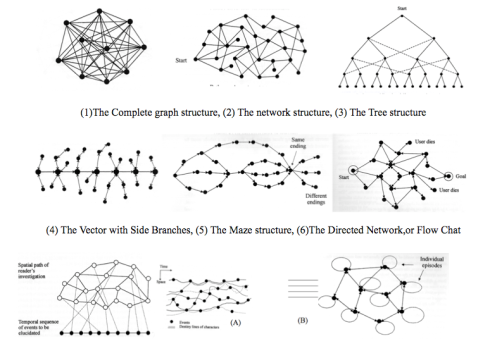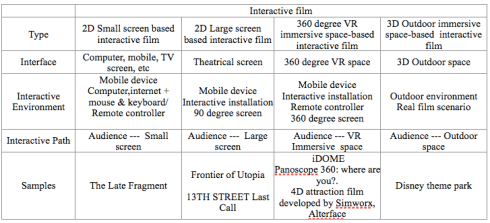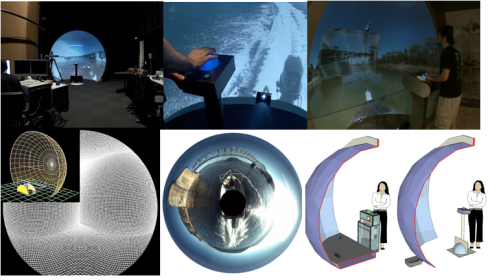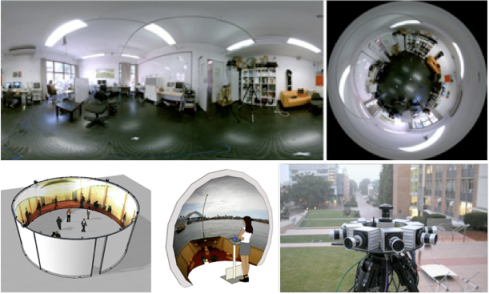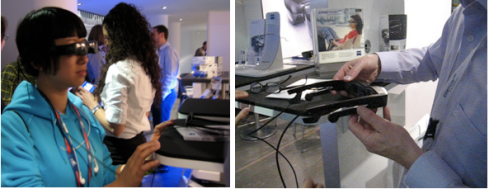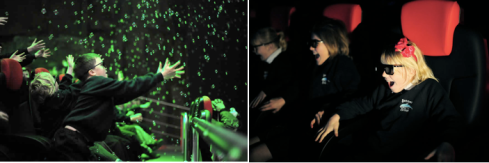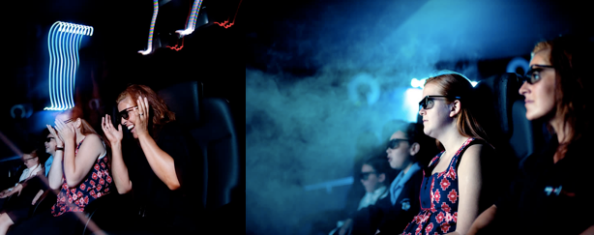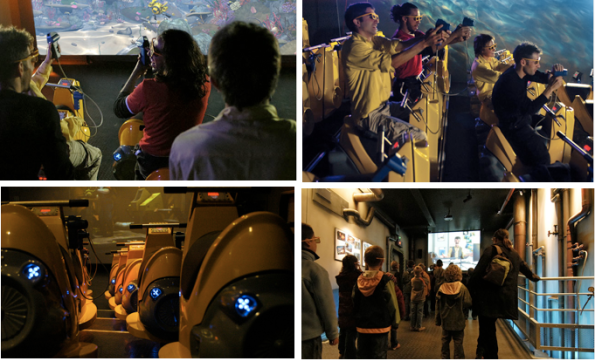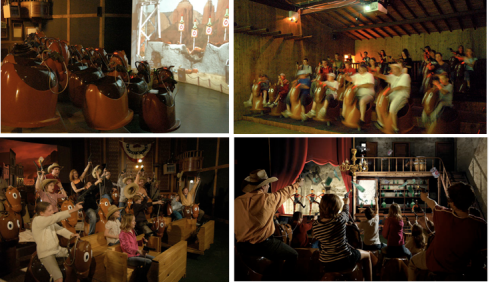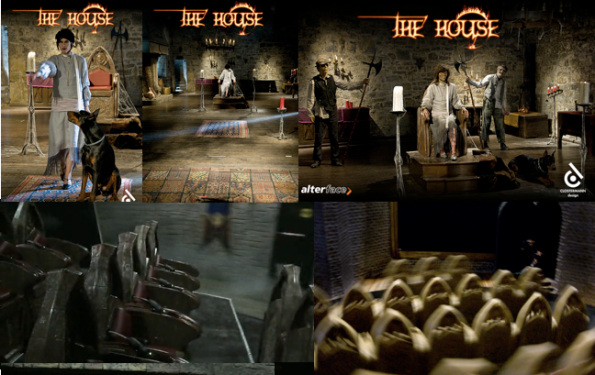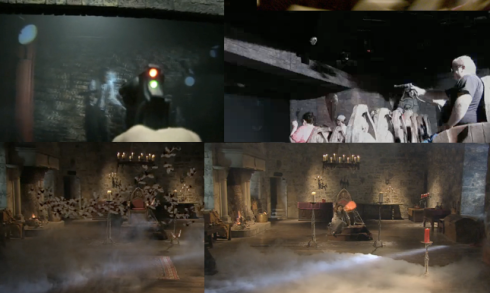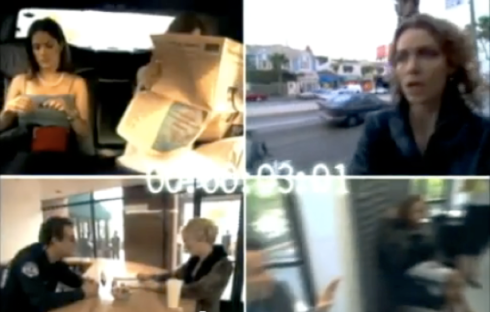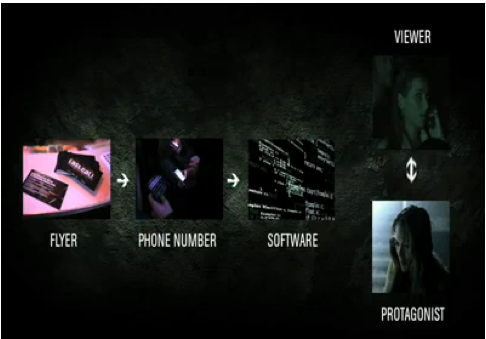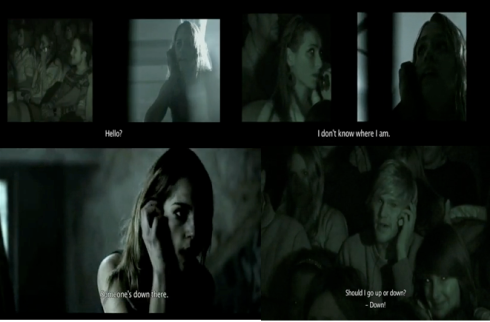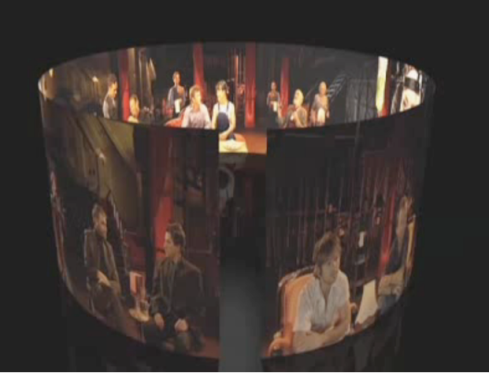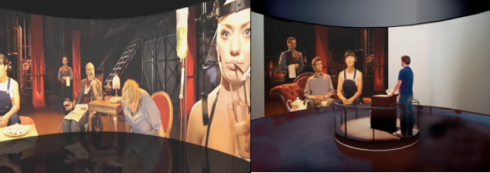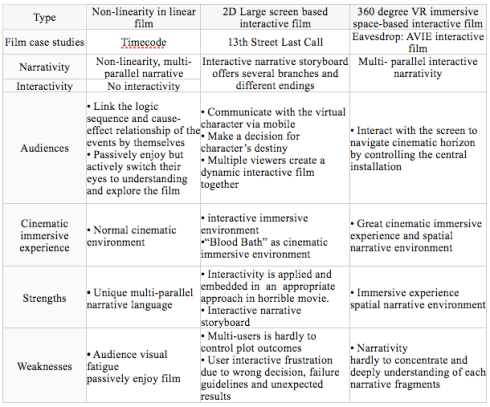Download my dissertation here dissertation weixuan zhao
{ How can interactive film challenge conventional film in the interactive media age? }
Weixuan Zhao July 2010
London College of Communication. MA Interactive Media 0910
Dissertation submitted in partial fulfillment as part of the requirements of the London College of Communication for the Masters of Arts degree in Interactive Media.
————————————————————————————————————————————-
Abstract
This dissertation presents a formalized academic research and discussion for interactive film that contains the theories, evidence, case studies, analysis and arguments in this specific field. It is for interactive film researchers, namely they are interactive media designers or artists, film directors or producers, narrative theorists or digital storytellers, etc. This dissertation has two objectives: (1) Analyzing interactive film itself through two aspects: Interactive film storyboard, Multi-sensory interactive cinematic immersion environment, which aims at researching the theoretical methods and practical approaches for embedding the pleasure of interactive media into film by taking advantage interactive media theories and technologies. (2) Analyzing three films in case studies chapter for comparatively analyzing between interactive film and conventional film in order to argue why interactive film can challenge the conventional film in interactive media age.
————————————————————————————————————————————-
Table of Contents
Abstract
Table of Contents
List of Tables
Chapter 1: Introduction
Chapter 2: Literature Review
2.1 Definition Clarification
2.2 Interactive Film
2.2.1 Interactive Film Storyboard
2.2.2 Multi-sensory Interactive Cinematic Immersion Environment
2.3 Does Film need Interactivity?
Chapter 3: Analysis of case studies
3.1 Timecode (2000)
3.2 13TH Street Last Call (2010)
3.3 Eavesdrop (2004)
Chapter 4: Findings
4.1 Relationship between Film, Cinematic Immersion Environment and Audience
4.2 Strengths and weaknesses of interactive film
4.3 How can interactive film challenge conventional film?
4.4 The future of interactive film
Chapter 5: Conclusion
Appendices
References
bibliography & webography
————————————————————————————————————————————-
Chapter 1: Introduction
Film is one of the most significant multi-dimensional media formats, which is rich of artistic value and commercial industrial prospects as well as broad audience group. As an interdisciplinary between interactive media and film, the research of interactive film attempts to link interactivity and film together in both theoretical and practical aspect, which would generate great academic value in both interactive media and film field. Furthermore, interactive film itself can be classified as a commercial field or a specific artistic branch of interactive narrative. As interactive film is one of the typical interactive narrative formats and entry-point, this dissertation also brings about significant theoretical value for other formats of interactive narrative. The innovative aspect of this dissertation is to explore 3D real space-based interactive film as a spatial narrative interactive media product in the development of multi-sensory immersive environment. Taking advantage of space as a place for interactive film storytelling would generate great influences and embarks new approach of interactive storytelling, film-making and broadly commercial market in both interactive media and film industry.
Film traditionally follow a linear approach and passive experience. Based on cutting-edge interactive media theories and technologies, however, interactive film now can open up film to advanced level of interactive narrative storyboard to offer audience a dynamic approach to interact with. Furthermore, interactive media offers us a chance to build intelligently multi-sensory interactive cinematic immersion environment for entertaining and engaging audiences. Although interactive film challenges the aesthetic charm of conventional film, it would engage audiences in terms of interactive narrative storyboard and multi-sensory interactive cinematic immersion experience. Thus, interactive film brings about great challenge for conventional film in the interactive media age.
Literature research methodology of this dissertation was conducted mainly on literature resources reading, films and relevant interactive projects gathering and interviews. As an interdisciplinary subject, the printed theoretical literature available focuses on Film Studies, Interactive Media, Virtual Reality, Interactive Narrative, Digital Storytelling, etc. The practical cases research based on a series of interactive film samples, interactive cinematic immersive environment projects and interactive media products. The interviews were conducted with five experts: film professors from Beijing Film Academy: Bin Wang, Yuanyuan Su, Xueyin Wang (Film producer), Lina Fan (Animated film director) and Fengtian Qiao (Dr. Animated film student from Communication University of China). They are specialized in film industry who toward innovative and critical thinking for conventional film and interested in interactive film. Based on the theoretical and practical research foundation of literature review, the case studies attempts to apply the research foundations of literature review and analyze three different type of films for horizontally analysis evaluation and comparison: Timecode(2000) (non-linear conventional film), 13th Street Last Call(2010) (2D Large screen based interactive film) and Eavesdrop (2004) (360 degree immersive VR space-based interactive film).
The dissertation attempts to analyze interactive film itself through two aspects: Interactive film storyboard, Multi-sensory interactive cinematic immersion environment, which aims at researching the theoretical methods and practical approaches for embedding the pleasure of interactivity into film by taking advantage interactive media theories and technologies. Case studies focus on comparatively analysis and evaluation between interactive film and conventional film. The findings section presents the main theoretical and practical exploration based on and supported by literature review and case studies, which aims at presenting the final discoveries on how interactive film can challenge the conventional film in interactive media age.
————————————————————————————————————————————-
Chapter 2: Literature Review
Literature survey: who did what:
As interactive film is a typical form of interactive narrative, the theories are based on Marie-Laure Ryan’s research of interactive narrative. The practical research based on a series of interactive film samples, interactive cinematic immersive projects and products developed by academic institutions, such as: iCinema Centre in UNSW, Interactive cinema group in MIT and Immersion studio in Tronto. Interactive media companies focus on interactive immersive theatre, such as Moviemex 3D, Simworx and Alterface. All this academic institutions, educators and companies are the main force to push interactive film theory and technologies forward to a more advanced level.
The Literature Review of this dissertation attempts to research and analyze interactive film through three aspects: (1) A series of definition clarifications related to interactive film. (2) Analyzing interactive film itself through two aspects: In Interactive narrative film storyboard, it analyzes how to embed interactivity into narrative film storyboard, and what kind of interactive narrative level and structure can fit for film model. In Multi-sensory interactive immerse cinematic experience environment part, the research focuses on how and what kind of interactive interface and medium, cutting edge interactive devices, installations and technologies can help interactive film to create digital intelligent cinematic immersive experience environment to offer audience multi-sensory interactive immersive experience. (3) discussing the great challenge for embedding interactivity into film.
2.1. Definition Clarification
Film: ‘Films communicate information and ideas, and they show us places and ways of life we might not otherwise know. Films offer us ways of seeing and feeling that we find deeply gratifying. They take us through experience. The experiences are often driven by stories, with characters we come to care about, but a film might also develop an idea or explore visual qualities or sound texture. A film takes us on a journey, offering a patterned experience that engages our mind and emotion’ (David & Kristin,1990, p.2). It can be deconstructed by two layers, one is plot layer, another layer beyond storyboard is multi-sensory immersive experience layer. The film logic is to transform plot into visual-audial immersive experience.
Interactive Media: ‘A new media object may be a digital still, digitally composited film, virtual 3-D environment, computer game, self-contained hypermedia DVD, hypermedia Website,or the Web as a whole’ (Manovich, 2001, p.14). ‘It is used extensively to describe works of new media and interactive art, encompassing everything from simple hyperlink to immersive virtual environments where the user navigate a 3-dimensional space with an infrared wand’ (Adrian,2000, p.20).
Interactive Narrative: Narrative can be defined as ‘the communication of a linked set of events’(Rimmon-Kenan,1983, p.23). Events are ‘a transition from one state to another caused, or experienced, by actors’(Bal, 1985, p.5).
Interactive Film: ‘ Interactive Film is strongly associated with digital media production, as the medium is based around the structure of conventional film, but allows the viewer a level of interaction that can only be achieved digital format’ (Quiddington,2005, p.12). Comparing with conventional film, interactive film tries to give the audience an active role and various approach of interactive control that allows them to participant and interact with film.
2.2 Interactive Film
2.2.1 Interactive Film Storyboard
Before concentrating on the analysis of interactive film, it is necessary to review three famous non-linearity films, which are well-know of aesthetic charm of non-linear storyboard structure and multiple story-line embed into linear film: (1) Reshomon
(1950) (fig 01), (2) Run Lola Run
(1999) (fig 02), (3) Time code
(2000) (fig 03). It is so exciting to see Reshomon event through different characters’ point of view with multiple story-line and go with director jumping flash-back and flash-forward. The audience can have multi-approaches to understand of the whole story. Time code audiences are quite busy to switch their eyes attention and link the events sequence by themselves to explore the film with curiosity in 90 minutes. Although, all of them do not offer audience any interactive freedom and no choices on how to discover the story itself due to the linear medium limitation, film directors and authors control the non-linear film storyboard, the great success of film box-office tests the charming and value of non-linearity, multiple story-line embed into films. This innovative film directors have strong will to change the traditional way of storytelling. But, is it enough just offer audience non-linear storyboard structure within linear film medium? No, audience needs to be involved with more interactive freedom. ‘A more elegant and dynamic way to reveal the story than non-interactive cut scenes it to make the actions of the user contribute directly to the disclosure and development of the plot’(Ryan, 2005). Now, Let’s move to interactive film.
fig 01: Reshomon (1950) fig 02: Run Lola Run (1999) fig 03: Time code (2000)
Reshomon (1950) [online image]. Available at: <http://www.fan-de-cinema.com/affiches/rashomon.html>
Run Lola Run (1999) [online image]. Available at: <http://www.cyber-cinema.com/galleryR/U_Z/>
Time code (2000) [online image]. Available at: <http://www.imdb.com/title/tt0220100/>
Based on Marie-Laure Ryan’s theoretical research of interactive narrative, this section mainly focus on how interactivity into narrative storyboard, namely it is interactive narrative levels and structures. Through analyzing existed successfully interactive films, this section aims at summarizing a possible solution for developing interactivity into film storyboard.
Which levels of interactivity should be applied in film
As Marie-Laure Ryan mentioned at peeling the onion: layers of interactivity in digital narrative texts, the interactivity into narrative storyboard structure can be separated for four levels :
‘ Level 1. Peripheral interactivity.
Level 2. Interactivity affecting narrative discourse and the presentation of the story.
Level 3. Interactivity creating variations in a partly pre-defined story.
Level 4. Real time story generation’ (Ryan, 2005).
At Level 1: Peripheral Interactivity, ‘interactivity affects neither the story itself, nor the order of its presentation’(Ryan, 2005). Take the first interactive film — Kinoautomat
(1967) (fig 04) for instance, the film storyboard structure has nine nodes, each scene is played after the last scene stops by following audience vote. The system asks audience to choose between two scenes and press red/green buttons which installed on each of the 127 seats in a custom-built cinema. In this film case, interactivity can not affect the story, but audience has the freedom to arrange the order of the events. It is much easier for film directors highly control the plot to offer audience peripheral freedom to navigate in the film storyboard, but Peripheral Interactivity level can not involves and engages audience due to the low level of interactivity.
fig 04: Kinoautomat (1967)
Kinoautomat (1967) [online image]. Available at: <http://www.kinoautomat.cz/foto.htm >
At Level 2: ‘Interactivity affecting narrative discourse and the presentation of the story, the interactive narrative storyboard allows the reader to retrieve more and more documents and to dig deeper and deeper into the database. With each of this probes the storyboard expands and reveals more stories, as the readers’ attention shifts from the main character to the secondary characters. With this type of interactivity, users are able to move freely around the story and to customize it to their own interests’ (Ryan, 2005). The appropriate interactive film example of discourse-level interactivity is Frontier of Utopia
(1995) (fig 05). It is a narrative database based interactive film that audience can selects sequences, choose characters he wants to watch and ask questions to the virtual characters. Audiences can attend virtual dinner party where all the characters and their personal objects are available for comparison in order to explore the story deeper and deeper. But, it is also limit of interactivity because audience can not affects the story itself. ‘To take interactivity to the level of story without freezing the narrative content of the text, we need more flexible schemes’ (Ryan, 2005).
fig 05: Frontier of Utopia (1995)
Frontier of Utopia (1995)[online image].
Available at: <http://www.medienkunstnetz.de/works/frontiers-of-utopia/>
At Level 3: Interactivity creating variations in a partly pre-defined story, ‘User play the role of a member of the story-world, and the system grants him some freedom of action, but the purpose of the users’ agency is to progress along a fixed story-line, and the system remain in firm control of the narrative trajectory’ (Ryan, 2005). The best example that fits for this level is 13th Street Last Call
, which viewers play the their own part and are able to communicate with the virtual protagonist via mobile call. The callers can give advice, navigate, instruct the virtual protagonist of his next mission or affect his destiny, etc. Because of this, multiple viewers in the theatre create a dynamic interactive film. Although all the scenarios are pre-defined via a huge database, the interactive narrative storyboard can offers several branches and multiple ending to make the user interaction more flexible and deeply involved into film.
At Level 4: Real time story generation, ‘stories are not pre-determined’ (Ryan, 2005). Audiences are fully involved into the core field of plot and have total freedom of interaction. They can play characters in the interactive film in real time. The real time interactive film aims at pushing audience into the core of film storyboard and change the “third person logic” to “first person logic” as the characters are audiences themselves. Film is all about you, plays with you, follow your opinion and response your decision. ‘There may come a day when computers have the ability to render and manipulate highly detailed 3-dimensional graphics in real-time. Every way the user looked the screen would change to match their point of view, and they just might feel like they are truly and interacting in an alternate world’ (Adrian,2000, p.47) Real time film would blur the boundary between virtual film scenarios and real-life scenarios.
In terms of building a real time interactive film storyboard, it needs a dynamic narrative database-based system. Each of the events is narrative fragment that has logical and consequential coherence that links by nodes. ‘Each different action of the user creates a different response from the system and consequently generates a different story. In such a system, the generation and presentation of the story would follow the chronological order of its events and reflect the temporal experience of the characters’ (Ryan, 2005). Users can swim in the self-renewable and never-ending narrative pool with a various and diversified series of stories. ‘The system is able to construct an infinite number of appropriate responses,which means the interactive narrative could create three forms of immersion: spatial (thanks to the 3D environment), temporal (the action takes place in real time), and emotional (the user deeply cares for his avatar). This type of system could be made interactive by handing over some decisions to the user. The user and the system could take turns generating events, and the story would be the product of their collaboration. The balance of control could be adjusted by giving more turns to the user or to the system. the story world will evolve somewhat randomly, rather than striving toward a global narrative pattern’ (Ryan, 2005).
Which interactive narrative structures are available to use
As Marie – Laure Ryan mentioned in her Narrative as Virtual Reality, she lists 9 possible interactive narrative structures (fig 06). All the images can be seen in Ryan’s Narrative as Virtual Reality. (Ryan, 2001,p247-255.fig.4-11): (1)The Complete graph structure, (2) The network structure, (3) The Tree structure, (4) The Vector with Side Branches, (5) The Maze structure, (6)The Directed Network,or Flow Chat, (7) The Hidden Story structure, (8) The Braided Plot, (9) Action Space,Epic Wandering and Story-World.
(1)The Complete graph structure, (2) The network structure, (3) The Tree structure
(4) The Vector with Side Branches, (5) The Maze structure, (6)The Directed Network,or Flow Chat
(7) The Hidden Story structure (8) The Braided Plot, (9) Action Space,Epic Wandering and Story-World.
fig 06: 9 possible interactive narrative structures
(Ryan, 2001,p247-255. fig.4-11)
The structure of (1),(3),(4),(5) are quite fit and much easier to embed into film structure. In the Complete graph structure, ‘every node is linked to every other node, and the reader has total freedom of navigation. This structure allows a free shuffling of text that makes it practically impossible to guarantee narrative coherence’ (Ryan,2001, p.247). In the Tree structure, although tree structure has limitation of flashback to the decision point, it is much easier to control and get a good result of well-formed multiple ending storyboard, that is why it is popular structure of interactive film storyboard. The Vector with Side Branches is an interesting interactive structure that the film directors can apply or embed it into film in a appropriately approach. Take an earthquake sense film for instance, the film director controls the key nodes
of the film, but give audience the interaction freedom to navigate himself to go anywhere he wants to see what happened after the shake: square rubble, destroyed interior room or the last conversation between the dying people. The Maze structure is fit for those film directors who are interested in offering audience multiple approaches to explore and discover the whole mystery films with surprise and curiosity. Because each of the events are narrative fragments and audience link the logic sequence between the events by himself, everyone has his own film version and different understanding towards the same film. There may not give the unify start point or end point for audience, but the process of trying to find the goal or entrance would look like navigate yourself in the puzzle that full of enjoyment and explorative pleasure.
As the whole section mentioned, there has basically four interactive levels and several interactive narrative structures can be applied into film storyboard. Choosing which kind of level or structure depends on specific film narrative content and format. It is advisable to find the most appropriately approach to embed into film storyboard without abuse of interactivity just for a new publicity gimmick.
2.2.2 Multi-sensory Interactive Cinematic Immersion Environment
This section mainly separate at four parts: (1) medium of interactive film: From 2D screen-based interface to 3D space-based cross-platform medium; (2) Interactive immersion of cinematic experience environment; (3) Multi-sensory user interaction. How and what kind of interactive interface and medium, cutting edge interactive devices, installations and technologies can help interactive film to create digital intelligent cinematic immersive experience environment to offer audience multi-sensory interactive immersive experience? The next 4 parts of this section would explore the theoretical and practical possibilities.
- Medium of interactive film
Since the new media technologies and platform generates great influence on how we bring film to our audience, the traditional film storytelling medium has been changed dramatically: from using photographic footage to record linear motion picture to computer-generated digital interactive moving image, from 2D screen, 3D VR
space to 3D real space, from single to cross-platform medium,etc. It is the time for us to reshape the communication medium between film storytellers and audiences as well as redefine film from 2D screen-based interface culture into spatial narrative
and cross-platform medium culture. ‘There is a clear trend in new media towards interactive systems where images, sound, and even the projection surface change in response to conscious and subconscious user activity. This heraids a new breed of cinema — an interactive environment where the one or more movie screens respond to your position, movements, speech, body temperature,etc. interactive cinema offers new ways of approaching user-driven participation media, and forces us to rethink out concept of narrative. Interactive cinema is more than an attempt to redefine an established medium–it is an attempt to create a new way of telling stories’ (Adrian,2000, p.98)
The table below illustrates the comparison of different types of interactive film. By classifying from display formats, interactive film can be roughly classified as four types: (1) 2D small screen based (computer, mobile, TV screen, etc.) interactive film; (2) 2D large screen (theatrical screen)based interactive film; (3) 3D 180-360 degree VR immersive space-based interactive film; (4) 3D outdoor immersive space-based interactive film. Type (2),(3) are the main focus of this dissertation. The horizontal comparison shows the experimental and revolutionary trend of interactive film: the interactive film storytelling interface expands from 2D screen to 3D real space. Space is the third dimensional interface which can largely expands the involving scale and possibilities of audience interaction and cinematic immersion experience.
table 01: Analysis of interactive film types via medium
Another great revolution is that interactive film develops from single to cross-platform medium. Based on current information technologies, individual mobile, home PC, theatre, experience space or even spatial narrative environment can link participants via internet, intelligent interactive installations or mobile devices. We should assume that film can be interacted with more digitalized, intelligent and portable environment in real time. Each user can be character or director to contribute, play and interact film via multi-dimensional cross platform and narrative database. Real time film generation can become true.
(2) Interactive immersion of cinematic experience environment
The most tremendous revolution comes from cinematic screen. Company like Moviemex 3D
developed Sliver screen which fits for 180 degree projection for 3D film, 4D attraction film, Ride film and Theme park. In 2004, Interactive cinema research group of Cinema Center in UNSW
developed 360 degree interactive screen called AVIE (fig 07), which can be used as an interactive medium for 3D spatial cinematic storytelling.
fig 07: AVIE AVIE (2004)[online image]. Available at: <http://www.icinema.unsw.edu.au/projects/infra_avie.html >
By projecting narrative fragments on the 360 degree screen, users can use the remote controller to interact with the screen and navigate themselves in the narrative pool. The system receives and responses users in real time through monitoring their movements and gestures via infra-red installation. It involves audience into spatial cinematic environment and builds the interactive tie between audience and virtual characters. Another appropriate experimental case from iCinema Centre is iDOME (fig 08). iDOME screen offers a spherical panorama interface for audience, which fits for 180 degree dome projected movie. All the video projected on the spherical panorama screen was shot via 360 degree global recording systems (fig 09). Through controlling track ball in front of screen, user can navigates himself in running spherical movie and feel entirely immerse in the current experience environment.
fig 08: iDOME
iDOME (2004)[online image]. Available
at: <http://www.icinema.unsw.edu.au/projects/infra_dome.html >
fig 09: 360 degree global recording systems
360 degree global recording systems (2004)[online image].
Available at: <http://www.icinema.unsw.edu.au/projects/infra_spherecam.html >
A similar interactive & cinematic immersion experience project called Panoscope 360: where are you?.(fig 10) Users can interact with the moving image by using a 3-axis controller. Panoscope 360 pushes audience inside in the cinematic narrative environment. Audience is static, but moving dynamic landscape allows audience to navigate himself through following any X, Y or Z axis dimensional in the virtual space. Immersive environment of Panoscope 360 makes audience dream they can jump space and time dimension due to allowing audience to go any immersive space he want to involve and interact with any other’s shared space. As interactive film screen transforms from 90 degree to 180 degree, or even 360 degree, it allows us to consider screen-based space film as a spatial narrative experience which can plays just surround you. The tremendous cinematic screen revolution would bring about new interactive approach of cinematic storytelling and exciting cinematic immerse experience environment.
fig 10: Panoscope 360: where are you?
Panoscope 360: where are you?(2009)[online image]. Available at: <http://panoscope360.com/>
Another innovative revolution is individual portable theatre called Cinemizer (fig 11), which I found it at FMX 2010
conference. The current price is €299 and it has a really good business market in Germany. It is a portable 3D opaque glasses connected with iPhone that allows audience to watch 3D film everywhere. By applying it into interactive film, individual can take iPhone as an intelligent input device to navigate and control the interactive film. Multiuser can create and explore multi-versional film through different interactive selections as well as communicate each other in interactive film through Wi-Fi.
fig 11: Cinemizer
Image from FMX 2010 : 15th Conference on Animation, Effects, Games and Interactive Media. Stuttgart,Germany: 04 May – 08 May 2010.
The innovative transformation of Interactive immersion experience environment also has been developed in interactive theatre. Supported by Simworx
company, the immersive experience theatre (fig 12) offers audiences intelligent effect seats (vertical drops, leg ticklers and vibration,etc), atmospheric effects (low smoke, snow, aroma, etc) and other dramatic effects (flashlights,wind,water splash,etc). Audience can feel the real breeze, grasps real bubbles or feel the real vibration simultaneously with the film senario when the pirate ship tossed terribly in the heavy sea. One of the interviewee Xueyin said, “When I watched a sea adventure movie in theatre, it was really cool all the audiences waved their arms, and the sea surface varies its surge to response our body motion!”
fig 12: immersive experience theatre (Simworx company)
Simworx company, the immersive experience theatre (2009)[online image]. Available
at: <http://www.simworx.co.uk/index_253.asp >
Alterface
company creates various genres of interactive film for multi-sensory interactive immersion experience in their interactive theatre, such as: Sea Safari (fig 13), In a Cart (fig 14), Desperados (fig 15), The House (fig 16), etc. The House is an horrible film that uses real cinematic objects to create real film scenarios. the audiences seats can quickly rotate between virtual cinematic scenarios to the real objects-based cinematic drama that blurs the boundary of cinematic reality and virtuality.
fig 13: Sea Safari
Sea Safari(2009)[online image]. Available
at: <http://www.alterface.com/en/interactive_theaters/sea_safari/medias/>
The narrative stories of these interactive film are related to game entertaining, exciting horrible exploration or educational purpose. Through using special interactive device (such as: laser gun, vibrational horse chair) and simulate effects, these interactive films aims at utilizing theatre as an immersive experience space to involve audience into film by attracting them using their body languages or triggering other sensory resonance.
fig 14 : In a Cart
In a Cart (2009)[online image]. Available
at: <http://www.alterface.com/en/interactive_dark_ride/in_a_cart/medias/>
fig 15:Desperados
Desperados (2009)[online image]. Available
at: <http://www.alterface.com/en/interactive_theaters/desperados/medias/>
Film theme park is another type of interactive immersive experience environment, such as Disney theme park. Some of the theme parks is based on MR
environment which the physical world properties and virtual objects co-exist in the same space simultaneously to allow audience interact with virtual and real objects and immerse themselves in virtual and real cinematic scenarios.
- Multi-sensory user interaction
It is true that traditional 2D screen-based film can give audiences wonderful audio-visual gluttonous, however, human sensory has been deprived and restricted by traditional virtual screen for quite a long time. We need more interactive freedom to touch, smell, move our body to feel films. Based on cutting-edge interactive media technologies, interactive film in spatial immersive environment offers audience an opportunity to engage multi-sensory user interactive experience. Audiences may become positive participants and interact with an arising enthusiasm due to making use of human sense to stimulate unexpected and variable responses with imagination expectation and surprise. They are totally involved and their body, any touchable object or even invisible atmosphere can become interactive medium to built the seamless link between virtual interactive films, physical environment and themselves.
As the whole section mentioned, from 2D screen-based conventional film to 3D space-based interactive film, from single communication medium to multi-dimensional cross – platform medium, from traditional passive audio-visual gluttonous to interactive multi-sensory immersive experience environment, new media technologies and platform have the marvelous power to help interactive film challenge the traditional way of film storytelling. Interactivity is not only can be existed in film storyboard layer. As third dimensional interface, “space” offers us another layer to embed interactivity into film, which is beyond film plot and storyboard. The multi-sensory interactive immerse cinematic experience environment gives interactive film dramatic energy. It also gives us a reason why we need interactive film. Audiences need to be involved in the film and communicate with the narrative space. Their body, behavior and psychological activity, mental models, illusion and imagination are the part of the film.
2.3 Does Film need Interactivity?
The first negative point of view of interactive film storyboard came from the interview of Lina Fan, who is a young chinese animated film director. She said, “most of the film directors would not like to give audience more interactive freedom. It is hard to control the interactive levels and storyboard structures because it would break through the whole narrative storytelling process if audiences have freedom of interaction, selection and decision. And the high level of interactivity needs too many choices and narrative branches that pre-determined by the authors or film directors for user to interact, which leads to increase cost that hardly seem worth and deserved. Another big challenge is that it threatens to the authority of film directors. Before trying to focus on interactive film, you should understand what is so called film. Traditional Hollywood blockbusters dominant film industry for quite a long time due to its irreplaceable aesthetic charm: director-controlled film language: plot, cause and effect, time and space, characters destiny, events, speed, motion, rhythm, bizarre, etc. It is true that under the Hollywood model, Hollywood film directors are better than audiences to know how to tell narrative stories to let audience follow his language path, fully accept his personal consciousness and passively release their emotion.”
But, is it enough for our audience just become observers to consume film passively? Or to become active participants to join in the film. Positive point of view came from the interviews of film professors and producers in Beijing Film Academy. Bin Wang said that Audiences have diversified personalities and hold different point of view toward their life and the film itself. To some extent, interactive film rather than linear narrative film can be satisfied with diversified audience psychological needs. Yuanyuan Su also mentioned that film as a artistic piece of work, the most important thing is that film needs a good narrative story, a good plot content. involving audience would trigger great entertainment of film.
Szperling is the executive producer of Uncompressed
, she ‘believes her hyper-story approach to filmmaking offer a deeper and more complex view of the world that the typical hollywood linear movie. Her audiences said, “You are outside the window looking in. But here, the window disappears and you feel you are a part of what happening.” Audience make a decision , and their decisions have consequences, being an active participant in a group drama’ (Miller, 2008, p.356). ‘By bringing interactivity to storytelling an author may better reach his / her audience and more profoundly affect them’ (Galyean, 1995, p. 59). Audience enjoy the to control and influence the film itself, and control and see the consequence just because our own action. Just like Szperling audiences said, ‘Tell me and i will forget, show me and i may remember, involve me and i will understand’ (Miller, 2008, p.357).
For my point of view, The motivation of interactive film are curiosity, involvement, pleasure and engagement: audiences are available to explore other’s never-ending life stories, imagine they are characters, their different decision directly link to different results, experience and participant different character’s lifestyle, enjoy, involve and influence character’s destiny and immerse themselves in the cinematic environment and have great reflective understanding about the film, the world and themselves.
This literature review chapter has presented a series of relevant theories, practical evidence, and discussion for analyzing interactive film. Through analyzing interactive film itself through two aspects: Interactive narrative film storyboard structure and interactive levels, and deep reviewing the transformational revolution of multi-sensory interactive immerse experience environment, this chapter has explored the theoretical and practical possibilities of embedding interactivity into film. Interactive film storyboard and multi-sensory interactive immerse experience environment are the two typical properties and benefits for interactive film. Thus, interactive film has great power to challenge the traditional film in interactive media age.
Chapter 3: Analysis of case studies
This case studies chapter includes three film cases: Timecode(2000) (non-linear conventional film), 13th Street Last Call(2010) (2D Large screen based interactive film) and Eavesdrop (2004) (360 degree immersive VR space-based interactive film). Choosing these three typical films as case studies, because each of them represent different type of film. Based on the theoretical and practical research foundation of literature review, the research methodologies are conducted on: (1) film case description, (2) horizontally comparison of narrativity, interactivity, cinematic immersive experience, (3) Through analysis and evaluation, the objective of case studies chapter is to support the main theme of interactive film can challenge conventional film as well as make feasible recommendations for interactive film optimization.
3.1 Timecode(2000) (non-linear conventional film)
Timecode (fig 17) is an experimental Drama Film in 2000, which is directed and written by Mike Figgis. It is well-know of aesthetic narrative charm of non-linearity storyboard structure and multiple story-line embed into linear film medium. The most innovative feature is that the film screen is divided into four small screen, which presents four independent movie clips simultaneously. The film director spent much concern on cinematic narrative format innovation. He almost canceled all the film cuts to let the four small movie clips become smooth narrative flow, but released the montage power for audiences to cut and deconstruct narrative time-space. Following the multi-parallel narrative structure, audiences are quite busy to switch their eyes attention and link the logic sequence and cause-effect relationship of those events in order to understand and explore the film with curiosity in 90 minutes.
Although Timecode can not completely follow all the conventional film storytelling rules as it break through linear narrativity. It still no interactivity and presents in a linear film medium. The reason why selecting Timecode as an example is that it can be considered as a innovative symbol and successful experimental case for film embedding non-linearity and multi-parallel narrativity. But it can not offer audience more freedom due to the linear medium limitation. The film language of Timecode can be illustrated as “The dance of wearing shackles”. Multi-parallel narrativity without interactivity leads to visual fatigue as audience can not disturb film progress. They switch their eyes quickly just do not want to lost any important scenarios but can not deeply understand the whole story within once. However, Timecode itself has its great artistic value and unique film language, which can not be cloned for too many times. There has a broad unknown space for innovative directors to explore interactive film.
fig 17: Timecode (2000) screen shot
Timecode (2000) screen shot [online image].
Available at: <http://www.youtube.com/watch?v=ajNXfx4FBOI >
3.2 13th Street Last Call (2D Large screen based interactive film)
13TH STREET Last Call (fig 18) promotes itself as “The First Interactive horrible movie in theaters” released at April 2010. The viewers are able to communicate with virtual characters via mobile call to help them make a decision in order to escape from the horrible scenarios in real time. Viewer send their phone number for a database, system selects a phone number and phones viewer, then a dialogue between viewer and character take place. The answer are converted into commands and system plays corresponding scene.
Although all the scenarios are pre-defined via a huge narrative database, the interactive narrative storyboard structure can offers several branches and different ending to make the user interaction flexibly and deeply into the storyboard. The director also built an interactive cinematic immersive environment called Blood Bath to recall and recover audiences’ memories of this horrible interactive film. It is so exciting the virtual character gives you a call and said, “I got your number, next victim is you!” when you immersed in virtual cinematic scenarios, surrounded with real horrible object-based simulated environment and accompanied other screamed audiences.
The strengths of 13TH STREET Last Call is that interactivity is applied and embedded in a really appropriate approach. Horrible movie is one of the suitable film genres for embedding interactivity as itself has strong explorative scenarios, curious character’s destiny, and staggered narrative structure. It is also quite effective to create artist effects for interactive cinematic immersive environment. Interactivity build the strong tie between audiences and film characters due to binding audiences decision and film characters’ destiny together. The audiences feel entirely being involved in the film as multiple viewers in the theatre can talk to the film characters directly and create a dynamic interactive film together. But the weaknesses of this movie is that it is hardly to control the dynamic interactive plot outcomes from multi-users. It may lead to user interactive frustration due to wrong decision, failure guidelines and unexpected results, but also the cinematic ending is hardly to pleased for everyone.
fig 18: 13TH STREET Last Call screen shot
13th Street Last Call (2010) sreen shot [online image]. Available
at: <http://www.youtube.com/watch?v=riMgAYensRI >
3.3 Eavesdrop (360 degree VR immersive space-based interactive film)
Eavesdrop (fig 19) is an experimental VR immersive cinematic project developed by iCinema group (Jeffrey Shaw and David Pledger) in 2004. It Presents by using AVIE
as an interactive cinematic experience that takes advantage of 360 degree screen as a spatial narrative environment. 10 characters circularly and continuously presents their performance in 9 minutes and all the movie clips are blurred the edge boundaries of each other to create a whole narrative loop. The theme of the cinematic script is about morality, which the audiences can watch the multi-narrative loop and listen to the character conversation of morality simultaneously. Each of the narrative clips has continuously repeated the literal keywords relevant to morality theme to let audience s’ emotion immerse in the narrative plot Intimation space. Audience also can interact with the screen to navigate their own cinematic horizon and select film scenes by controlling the central installation.
Eavesdrop presents an feasible solution and visible scenario to apply 360 degree VR immersive experience as a spatial narrative environment for interactive film storytelling. 360 degree VR environment offers engaging cinematic immerse experience and significant innovation for future parallel interactive narrative film storytelling, however, similar to the most 360 degree interactive spatial narrative projects and products, the weakness is that audiences hardly to concentrate on the surrounding spatial narrative plot and can’t get deeply understanding of each narrative fragments. Interactivity, to some extent, relieves cinematic plot logic presentation.
fig 19: Eavesdrop screen shot
Eavesdrop (2004) sreen shot[online image]. Available
at: < http://www.icinema.unsw.edu.au/projects/prj_eavesdrop.html >
Table 02: Comparison of film cases
After analysis the three film cases separately and horizontally compare them from narrativity, interactivity, cinematic immersive experience aspects. It is obvious that interactivity deconstruct coherent narrativity as narrative fragments, however, no matter the structure is multi-parallel interactive narrativity (Eavesdrop) or the tree structure with several branches and different endings(13th Street Last Call), the interactive film cases support that interactive narrativity can have its own attractive storytelling language charm if we embed it in the correct path. Secondly, different information communication medium and approaches contribute to different interactive storytelling engagement, 13th Street Last Call engages audience in terms of interactive narrative plot, but Eavesdrop concentrates on interactive immersive experience and spatial narrative environment. It is meaningless and hard to compare which way is more advanced. It is just different interaction entry-point. Thirdly, Interactivity is designed and served for our audiences. The more interactive freedom we give to our audiences, the more they being involved and more active than conventional audiences which directly connects and contributes to their cinematic experience. Interactivity improve the experience and participation of film.
Chapter 4 Findings
This findings section outlines the main theoretical and practical discoveries based on and supported by literature review and case studies: (1) The relationship between film, cinematic immersion environment and audience, (2) Strengths and weaknesses of interactive film, (3) How can interactive film challenge conventional film, (4) The future of interactive film. This section aims at presenting the final exploration on how interactive film can challenge the conventional film in interactive media age.
4.1 Relationship between Film, Cinematic Immersion Environment and Audience
In 90 minutes traditional film, film director presents film and convey emotional and sensory resonance for audience by using screen medium. He enforces audiences passively release their emotion and fully accept his personal consciousness. In terms of media information communication, the information flow follows the single direction path from film to audience, which can not reach the advanced communication level due to missing feedback from audience’s mental model return into film. Through embedding interactivity into film, the information communication channel is quite free and sooth as there has two-way interaction between audiences and film. By taking advantage of using space as cinematic immersive environment, there has strong relationship between interactive film, cinematic immersive environment and audiences due to each of the three elements becoming interface and reflexive feedback loop for influencing each other.
4.2 Strengths and weaknesses of interactive film
Interactive narrative storyboard and multi-sensory interactive immerse experience environment are the two typical properties and benefits for interactive film. Interactivity deconstructs coherent narrativity as narrative fragments and challenges the authority of film directors controlled plot, however, no matter what kind of interactive narrative structure be applied in film (tree structure, multi-parallel interactive narrativity, etc), interactive narrativity has its own narrative film language charm of unordered, random, dynamic approach and multi-path of interaction,etc. Furthermore, by expanding space as the third dimensional interactive interface (mainly they are virtual reality or mixed reality space), the spatial interactive narrativity in the development of cinematic immersion experience environment can involve audience into film and inspire their multi-sensory resonance to feel film. Audiences’ body, interactive behavior and psychological activity, mental model, illusion and imagination are the part of the film.
The main problem of interactive film is hard to keep aesthetics balance between interactivity and narrativity. Reviewing the interactive film cases and samples mentioned in literature review and case studies chapters, it is much harder than traditional film to control the storyboard and find an appropriate approach to let audience get deeply understanding of each narrative fragments at the same time enjoy interactive engagement. Interactivity disturbs linear narrativity and relieves cinematic plot presentation. The current interactive films are still stay in experimental test process which are not very mature and have some problems or weaknesses need to be challenged. But, every kind of meaningful theoretical and technological improvement in both interactive media and film field would push interactive film go forward.
4.3 How can interactive film challenge conventional film?
The charm of conventional film is that it displays unlimited virtual space and time within limited space and time. By embedding interactivity into film, film can be presented in any moving spatial narrative environment without time limitation, which largely expands the narrative medium and inspires dynamic storytelling approach. Interactive film has more freedom in terms of time and space, which allows audiences’ Imagination, illusion and memorialization jump freely beyond real time and space. It also blurs the boundary between virtual film and real life to meet audience’s needs and satisfaction about emotional experience and sensory resonance.
Interactivity is designed and served for our audiences. The more interactive freedom we give to our audiences, the more they being involved and more active than conventional audiences which directly connects and contributes to their cinematic experience. The motivation of interactive film are curiosity, involvement, pleasure and engagement. Interactivity improve the audience experience and participation of film, which brings about great challenge for conventional film.
4.4 The future of interactive film
The future landscape of interactive film should be defined as: audience-driven dynamic narrative database-based real time interactive film presents as spatial narrative in multi-sensory immersive experience environment. Audiences have fully interactive freedom in screen, space and time dimension, the interactive film change itself to match audiences mental models to let them experience and immerse as well as have a great reflective understanding about the film, the world and themselves.
Chapter 5: Conclusion
In conclusion, the whole dissertation research focused on how can interactive film challenge conventional film in the interactive media age. Through presenting interactive media and film theories, evidence, case studies, analysis and arguments in this specific interdisciplinary field, this dissertation analyzed the theoretical methods and practical approaches for embedding the pleasure of interactive media into film by taking advantage interactive media theories and technologies. Comparatively analyzing between interactive film and conventional film in order to explore how interactive film can challenge the conventional film in interactive media age.
Interactive narrative storyboard and multi-sensory interactive immerse experience environment are the two typical properties and benefits for interactive film. Since the new media technologies and platform generates great influence on how we bring film to our audience, the traditional film storytelling medium has been changed dramatically. New media technologies and platform have the marvelous power for interactive film challenge the traditional way of film storytelling.
Through exploring 3D real space-based interactive film in the development of multi-sensory immersive environment, interactive film offers us a huge unknown space to explore and discuss in terms of interactivity, narrativity, and multi-sensory immersive experience environment. From linear 2D screen-based audio-visual gluttonous to spatial interactive multi-sensory immersive experience, film itself experiences the great transformation. In the future landscape of film, real time interactive film would just happen surround you, play with you and involve you in the scenarios. Your behavior and decision directly generates part of the story. Interactive film blurs the boundary between illusion and reality as well as virtual film and real life scenarios. Who we are? What is so called film? What is the new way to look at the world and ourselves should be deconstructed and reshaped.
As an interdisciplinary between interactive media and film, this dissertation also brings about significant theoretical and practical value for both the two academic filed, which would generate great influences and embarks new approach of interactive storytelling, film-making and broadly commercial market in both interactive media and film industry.
Reference
bibliography & webography
- Bal, M.(1985) Narratology : introduction to the theory of narrative. Toronto ; London : University of Toronto Press
- David B, Kristin T. (1990) Film art : an introduction. 3rd ed. New York ; London : McGraw-Hill.
- Manovich, L. (2001) The language of new media. London : MIT Press.
- Miller, C.H.(2008) Digital storytelling : a creator’s guide to interactive entertainment. 2nd ed. Amsterdam ; Boston : Focal Press
- Quiddington, A. (2005) Why has interactive film failed to become a popular medium? Unpubished B.A. Digital Media Production Thesis. London College of Communication. Unviersity of the Arts London.
- Ryan, M-L. (2001) Narrative as virtual reality: immersion and interactivity in literature and electronic media. Baltimore ; London : Johns Hopkins University Press
- Rimmon-Kenan,S. (1983) Narrative Fiction:Contemporary Poetics. Routledge,London.
- Adrian,J. (2003) Object-Oriented Interactive Cinema. Master of Applied Science, Interactive Art (MASc-IA) Thesis. School of Interactive Art and Technology, Simon Fraser University. [Internet] Available from: <http://ir.lib.sfu.ca/bitstream/1892/9783/1/b30626924.pdf> [ Accessed 15th June 2010].
- Galyean, T. (1995) Narrative Guidance of Interactivity. [Internet]. PhD Thesis. Massachusetts Institute of Technology. Available from: <http://mf.media.mit.edu/pubs/thesis/tagPHD.pdf> [ Accessed 17th June 2010].
- Interactive Cinema (2001)Moviemaker, Fall, p.14. [Internet] Available from:<http://www.moviemaker.com/magazine/issues/44/cinevation.html> [ Accessed 7th July 2010].
- Ryan, M-L. (2005) Peeling the Onion: Layers of Interactivity in Digital Narrative Texts. [Internet] Available from: <users.frii.com/mlryan/onion.htm> [ Accessed 20th June 2010].
Film
- 13th Street Last Call. (2010) Directed by Matthias Stiller and Wolfgang Schneider. Berlin,Greman. [Interactive film].
- Eavesdrop (2004) Directed by Jeffrey Shaw, David Pledger [Interactive film]
- Frontiers of Utopia. (1995) Directed by Jill Scott. German. [Interactive film].
- Kinoautomat. (1967) Directed by Radúz Činčera. German. [Interactive film].
- Reshomon. (1950) Directed by Akira Kurosawa. Japan. [Video: DVD].
- Run Lola Run. (1998) Directed by Tom Tykwer. German. [Video: DVD].
- The Late Fragment. (2007) Directed by Daryl Cloran, Anita Doron, Mateo Guez. Canadian. [Interactive film].
- Timecode. (2000) Directed by Mike Figgis. American. [Video: DVD].
- Uncompressed. (2000) Directed by Margi Szperling [Interactive film]
Interactive media projects and products
- 360 degree global recording systems (2004) [240 x 360 degree digital video camera system and post-production facilities] developed by the iCinema Centre in UNSW. Information available at <http://www.icinema.unsw.edu.au/projects/infra_spherecam_1.html >[ Accessed 12th July 2010].
- AVIE (2004) [Interactive cinema] developed by the iCinema Centre in UNSW. Information available at <http://www.icinema.unsw.edu.au/projects/infra_avie.html> [ Accessed 27th June 2010].
- Disney theme park (2007) [Theme park] developed by Disney company. Information available at <http://disneyworld.disney.go.com/theme-parks/>[ Accessed 4th July 2010]
- iDOME (2004) [Interactive Hardware/software platform] developed by the iCinema Centre in UNSW. Information available at <http://www.icinema.unsw.edu.au/projects/infra_dome.html>[ Accessed 25th June 2010].
- Interactive theatre (2006) [immersion experience theatre] developed by Simworx. Information available at <http://www.simworx.co.uk/index_001.asp >[ Accessed 17th July 2010]
- Panoscope 360: where are you? (2005) [immersive existence simulator and telepresence apparatus] developed by Luc Courchesne. Information available at < http://panoscope360.com/>[ Accessed 22th June 2010].
- Sea Safari, In a Cart, Desperados, The House (2004) [interactive Cinematic products] developed by Alterface. Information available at <http://www.alterface.com/en/home/>[ Accessed 17th July 2010]
- Sliver screen (2005) [180 degree screen] developed by Moviemex 3D company. Information available at <http://www.moviemex3d.com/>[ Accessed 13th July 2010].
Images
- 13th Street Last Call (2010) sreen shot [online image]. Available at: <http://www.youtube.com/watch?v=riMgAYensRI >[Accessed 11 July2010].
- 360 degree global recording systems (2004)[online image]. Available at: <http://www.icinema.unsw.edu.au/projects/infra_spherecam.html >[Accessed 16 July2010].
- AVIE (2004)[online image]. Available at: <http://www.icinema.unsw.edu.au/projects/infra_avie.html >[Accessed 04 July2010].
- Cinemizer (2010) Image From FMX 2010 : 15th Conference on Animation, Effects, Games and Interactive Media.Stuttgart,Germany: 04 May – 08 May 2010.
- Desperados (2009)[online image]. Available at: <http://www.alterface.com/en/interactive_theaters/desperados/medias/>[Accessed 04 July2010].
- Eavesdrop (2004) sreen shot[online image]. Available at: < http://www.icinema.unsw.edu.au/projects/prj_eavesdrop.html >[Accessed 11 July2010].
- Frontier of Utopia (1995)[online image]. Available at: <http://www.medienkunstnetz.de/works/frontiers-of-utopia/>[Accessed 12 July2010].
- Kinoautomat (1967) [online image]. Available at: <http://www.kinoautomat.cz/foto.htm >[Accessed 13 July2010].
- iDOME (2004)[online image]. Available at: <http://www.icinema.unsw.edu.au/projects/infra_dome.html >[Accessed 07 July2010].
- In a Cart (2009)[online image]. Available at: <http://www.alterface.com/en/interactive_dark_ride/in_a_cart/medias/>[Accessed 04 July2010].
- Panoscope 360: where are you?(2009)[online image]. Available at: <http://panoscope360.com/>[Accessed 12 July2010].
- Reshomon (1950) [online image]. Available at: <http://www.fan-de-cinema.com/affiches/rashomon.html> [Accessed 13 July2010].
- Run Lola Run (1999) [online image]. Available at: <http://www.cyber-cinema.com/galleryR/U_Z/>[Accessed 14 July2010].
- Ryan, M-L. (2001) Narrative as virtual reality: immersion and interactivity in literature and electronic media. Baltimore ; London : Johns Hopkins University Press
- Sea Safari(2009)[online image]. Available at: <http://www.alterface.com/en/interactive_theaters/sea_safari/medias/>[Accessed 04 July2010].
- Simworx company, the immersive experience theatre (2009)[online image]. Available at: <http://www.simworx.co.uk/index_253.asp >[Accessed 04 July2010].
- The House(2009)[online image]. Available at: <http://www.alterface.com/en/haunted_house/the_house/medias/ http://www.youtube.com/watch?v=YhKTSgrwo-A >[Accessed 10 July2010].
- Time code (2000)[online image]. Available at: <http://www.imdb.com/title/tt0220100/>[Accessed 11 July2010].
- Timecode (2000) sreen shot [online image]. Available at: <http://www.youtube.com/watch?v=ajNXfx4FBOI >[Accessed 11 July2010].
Interviews
- Bin, W. (2010) Interview with film professor. London, 25 May. [Bin Wang has worked as a film professor in Beijing Film Academy since 1994]
- Fengtian, Q. (2010) Interview with animated film technology Phd. student. London, 11 July.[Fengtian Qiao has studied in Communication University of China for animated film Dr. degree since 2008]
- Lina, F. (2010) Interview with animated film director. London, 10 April. [Lina, F. has worked as a animated film director since 1996]
- Xueyin, W. (2010) Interview with film producer. London, 13 April. [Xueyin Wang has worked as a film producer since 2005]
- Yuanyuan, S. (2010) Interview with film professor. London, 19 May. [Yuanyuan Su has worked as a film professor in Beijing Film Academy since 1999].
